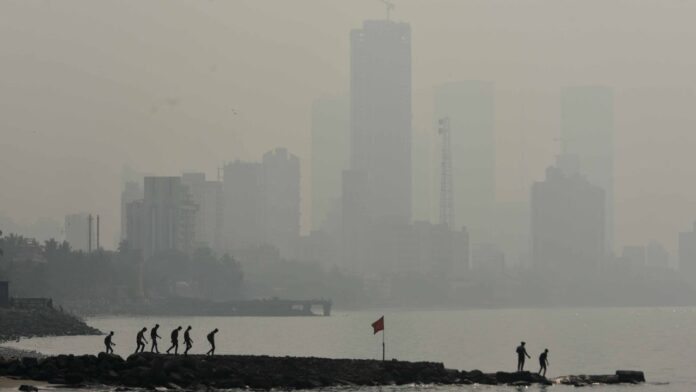Pollution in Mumbai has reached alarming levels, marking one of the most contaminated months in the city’s history. Once considered relatively shielded from extreme air pollution compared to cities like Delhi, Mumbai is now grappling with deteriorating air quality. The sudden rise in pollution has triggered concern among residents, environmentalists, and health experts alike. Multiple factors, including construction projects, vehicular emissions, and changing weather patterns, are believed to have contributed to this environmental crisis.
Construction Activities and Metro Projects
Mumbai’s ongoing infrastructure development is among the key contributors to its rising pollution levels. The city is witnessing large-scale construction projects, including metro rail expansion, road repairs, and real estate development. These activities generate significant amounts of dust, a primary component of particulate matter (PM10 and PM2.5) that pollutes the air.

The lack of adequate dust suppression measures exacerbates the problem. Without proper watering of construction sites or the use of advanced dust-control technologies, dust particles are released into the atmosphere, settling over residential areas and contributing to a noticeable decline in air quality.
Vehicular Emissions
Mumbai’s roads are densely packed with vehicles, with private cars making up a significant portion of the traffic. The emissions from these vehicles, particularly older ones that fail to meet modern emission standards, release harmful pollutants like nitrogen oxides (NOx), carbon monoxide (CO), and volatile organic compounds (VOCs).
Despite efforts to promote public transport and the introduction of cleaner fuel alternatives, the sheer number of vehicles on the road continues to overwhelm the city’s air quality management systems. Traffic congestion exacerbates the problem, as idling vehicles emit more pollutants into the atmosphere.
Industrial and Port Activities
Mumbai’s industrial zones and port areas also contribute heavily to pollution. Factories emitting smoke and particulate matter, coupled with emissions from cargo ships docked at Mumbai’s ports, add to the city’s pollutant load. The use of low-quality fuel in some industries and cargo vehicles further aggravates the situation.
Changing Weather Patterns
Meteorological factors play a crucial role in pollution levels. Shifts in wind patterns and reduced wind speeds during certain periods lead to the stagnation of pollutants in the lower atmosphere. This creates a smog-like condition, where particulate matter and harmful gases remain suspended, making it harder for the pollutants to disperse.
Additionally, Mumbai’s relatively high humidity levels can cause pollutants to mix with moisture in the air, forming secondary pollutants that further degrade air quality.
Dust and Roadside Pollution
Dust generated from roadside activities such as garbage burning, unpaved roads, and the movement of heavy vehicles contributes to the rising levels of particulate matter in the air. Despite regulations prohibiting open garbage burning, the practice continues in several parts of the city, releasing harmful toxins into the environment.
Use of Contaminated Fuel and Oil
The use of contaminated or low-grade oil in vehicles and industrial activities is another factor responsible for Mumbai’s worsening air quality. Such fuels produce higher levels of harmful emissions compared to cleaner alternatives. Efforts to regulate and phase out low-quality fuels have been slow, allowing pollution levels to rise unchecked.

Health Implications of Rising Pollution
The spike in air pollution poses serious health risks to Mumbai’s residents. Long-term exposure to pollutants like PM2.5 and PM10 is linked to respiratory problems, cardiovascular diseases, and weakened immune systems. Vulnerable populations, including children, the elderly, and those with pre-existing health conditions, are at the greatest risk.
Reports of increased cases of asthma, bronchitis, and other respiratory ailments have already surfaced. Health experts have urged residents to take precautions, such as wearing masks, using air purifiers, and avoiding outdoor activities during peak pollution hours.
What Needs to Be Done?
To combat the sudden rise in pollution, coordinated efforts are needed across multiple sectors:
- Stringent Regulation of Construction Activities: Strict enforcement of dust-control measures, including the mandatory use of sprinklers, covering of construction materials, and real-time monitoring of air quality around construction sites.
- Promotion of Public Transport: Encouraging the use of public transport through subsidies, expanded metro connectivity, and improved bus services can reduce the number of private vehicles on the road.
- Emission Standards Enforcement: Ensuring that all vehicles meet the latest emission norms and phasing out older, polluting vehicles from Mumbai’s roads.
- Industrial Emission Controls: Strengthening monitoring and regulation of emissions from factories and port activities, including transitioning to cleaner fuels.
- Awareness Campaigns: Educating citizens about the impact of pollution and encouraging eco-friendly practices such as carpooling, reducing waste, and conserving energy.
A Collective Responsibility
The sudden rise in pollution in Mumbai is a wake-up call for the city to prioritize sustainable urban development and environmental protection. While policy changes and infrastructure upgrades are essential, the active participation of citizens is equally crucial. By adopting cleaner practices and supporting green initiatives, Mumbai can aspire to reclaim its status as a city with cleaner air and a healthier living environment.

